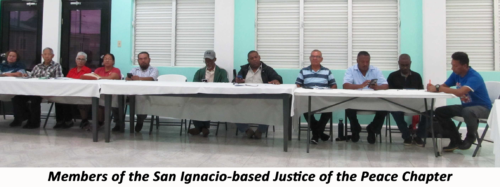Photo: Sergeant Steven Parham from the San Ignacio police formation explains police procedures to the Justices of the Peace
“To serve with the pen, which is mightier than the sword.” — the Association of Justices of the Peace
by Orlando Pulido
SANTA ELENA TOWN, Cayo District, Mon. Nov. 6, 2023
The San Ignacio-based Justice of the Peace Chapter met at the Cayo Center for Employment Training on Sunday evening, November 5. The purpose of the meeting was to train Justices of the Peace on procedures to be followed when carrying out their duties, especially with the police.
Chairing the meeting was long-standing Justice of the Peace and president of the Peace Chapter, Mr. Raymond Cox. He reminded the Justices of the Peace that the Justice of the Peace Act was being updated, to be more stringent with those who charge for their services. Also, Justices will soon need to sign a life certificate every two years.

Police prosecutor attached to the San Ignacio police formation, Sergeant Steven Parham was present to detail police procedures with Justices of the Peace. He stated that only magistrates and Justices of the Peace have the authority to sign a search warrant for police to enter a residence to do a particular search. If in the course of the search, stolen items are found in the house, then another search warrant will be required by the police, which also needs to be signed by a Justice of the Peace. In that case, a police officer will be placed on standby while the second warrant is being processed. Parham recommended that the Justice of the Peace remain with a copy of the search warrant.
Parham also explained that where a magistrate is not available to process a detained person, a Justice of the Peace can sign a bail form. Persons in custody such as pregnant women charged for “summary matters” can normally be granted bail, but that requires the signature of a Justice of the Peace.
Then there are special cases where Justices of the Peace are needed by the police, such as when a person is being held in custody for an extended time, such as on weekends. Sergeant Steven Parham said that it is a good practice for Justices of the Peace to visit the police station to speak to the persons in custody.
Justice of the Peace, Desol Neal then took the opportunity to speak about the role of Justices of the Peace whilst a person is in detention. When a person is detained by a police officer, that person should immediately be informed of the reason for his or her detention. While in detention, police are to document it in the prisoner’s diary. In regard to interviews carried out by police, Desol Neal explained that the questioning of the suspect must be conducted “… to give them a fair chance to say what occurred.” Also, a station interview is conducted in the presence of a Justice of the Peace for transparency reasons and for there to be no allegations of police brutality.
Police prosecutor George Gomez was also present to also inform Justices of the Peace on police procedures. Gomez recommended to the association’s president, Mr. Raymond Cox, that a team of Justices of the Peace be formed to do the caution statements. (Currently, there is an over-reliance on a few Justices of the Peace to fill out the caution statements.) Eventually, they may do away with the caution statements and use video as evidence instead, Gomez reported.
At these meetings the subject of remuneration of Justices of the Peace whilst conducting their duties, especially when it involves long-distance travel, has come up repeatedly. Police prosecutor George Gomez stated that “… the issue with remuneration, the president [of the Association of Justices of the Peace] will have to deal with it.”
The Association of Justices of the Peace has members across Belize. Their motto is: “To serve with the pen, which is mightier than the sword.”

